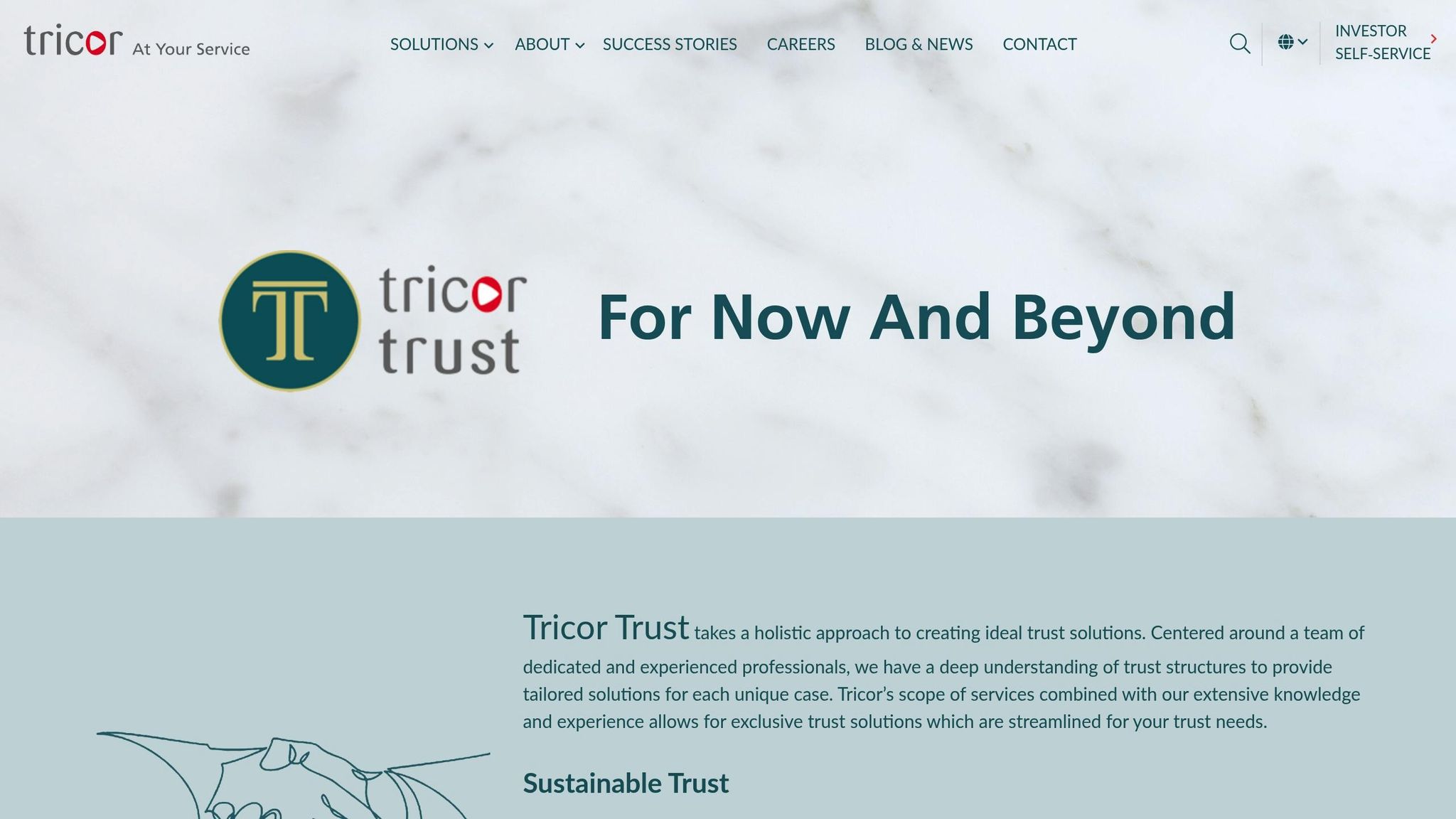Managing wealth in Canada requires clear strategies across key areas like asset allocation, tax planning, and estate management. For individuals with $1M+ in liquid assets, small missteps can lead to significant losses. This guide breaks down practical steps to protect and grow your wealth:
- Diversify Investments: Balance portfolios with cash, equities, fixed income, and alternatives like real estate or private equity. Include global investments for broader opportunities.
- Tax Strategies: Maximize tax-advantaged accounts (e.g., TFSAs, RRSPs) and adapt to provincial tax rules to reduce liabilities.
- Estate Planning: Regularly update wills, design trusts, and use tools like family trusts or estate freezes to ease wealth transfer.
- Risk Management: Use insurance (life, critical illness) to safeguard assets and ensure smooth wealth transition.
- Private Banking: Access tailored services for lending, investments, and cross-border needs.
Tricor Trust x RBC x DLA Piper: The essential checklist for moving to or investing in Canada

Asset Diversification Strategies
Diversification isn’t just about owning a variety of stocks. For high-net-worth Canadians, it involves thoughtfully spreading investments across different asset classes, geographic regions, and market sectors. This approach helps reduce risk while aiming for growth. In fact, ultra-high-net-worth (UHNW) investors allocate nearly 50% of their portfolios to alternative investments, compared to just 5% for standard investors.
This stark difference often explains why wealthier investors achieve stronger risk-adjusted returns. By tapping into investments with low correlation to public markets, they can unlock growth opportunities and enjoy regular income streams. A great example of this strategy is the Canada Pension Plan Investment Board, which diversifies across public and private equities, fixed income, credit, real estate, and infrastructure, while also spreading investments globally. Let’s explore how to effectively balance these asset classes.
Balancing Asset Classes
A robust portfolio for high-net-worth individuals goes beyond the basics of stocks and bonds. It should include a mix of cash equivalents, public equities, fixed income, and alternative investments.
- Cash Equivalents (5–10%): These provide liquidity for emergencies or new opportunities. Examples include high-interest savings accounts, guaranteed investment certificates (GICs), and money market funds.
- Public Equities: While still essential for long-term growth, equities typically make up a smaller proportion in strategic portfolios. A balanced approach might focus on Canadian dividend-paying stocks, U.S. growth equities, and exposure to international markets.
- Fixed Income: This category ensures stability and steady income. Options like government bonds, corporate bonds, and preferred shares are common. Laddering bond maturities can help manage reinvestment risks, especially during fluctuating interest rates.
- Alternative Investments: For wealthy Canadians, alternatives play a key role. Private equity, venture capital, and real estate - whether through direct ownership, REITs, or Mortgage Investment Corporations (MICs) - offer diversification beyond traditional markets. Other options like commodities, hedge funds, and private debt add further layers of diversification. Although these often require higher minimum investments and may limit access to funds, they bring benefits that traditional assets can’t match.
Beyond asset classes, spreading investments geographically is another critical layer of diversification.
Domestic and International Investments
Geographic diversification is essential for building a resilient portfolio. Canada’s market represents less than 5% of the global investible universe, so relying solely on domestic investments can limit growth and increase risk concentration.
- Domestic Investments: Canadian assets should form the core of your portfolio, offering familiarity, tax advantages, and alignment with local expenses.
- International Investments: Expanding globally unlocks opportunities across diverse markets. The U.S. provides access to tech leaders and innovative companies, while Europe and Asia offer exposure to different industries and economic cycles. Emerging markets, such as India and Brazil, may deliver higher growth potential, though they come with added volatility.
Managing currency risk is crucial when investing internationally. Currency fluctuations can either boost returns or lead to losses. Some investors hedge against this risk, while others see it as another form of diversification. To further spread risk, consider diversifying across sectors like technology, healthcare, consumer goods, and industrials.
Portfolio Review and Rebalancing
Keeping your portfolio aligned with your goals requires regular reviews. Aim to assess your portfolio every six months to avoid impulsive decisions and unexpected tax consequences. However, certain life events may call for more frequent adjustments.
- Threshold-Based Rebalancing: If an asset allocation strays significantly from its target range, adjustments are necessary to bring it back in line.
- Life Changes: Events like a new job, inheritance, business sale, marriage, or retirement can alter your financial goals and risk tolerance, making a portfolio review essential.
When rebalancing, it’s important to account for tax implications. Selling investments in taxable accounts may trigger capital gains taxes, though losses can offset some of the tax burden. Using tax-advantaged accounts like RRSPs and TFSAs can help minimize immediate tax impacts.
To reduce market timing risks, consider shifting allocations gradually over several months. Monitoring how asset classes correlate during periods of market stress ensures your diversification strategy remains effective. Regular performance evaluations can highlight areas for improvement, and professional wealth managers can provide valuable guidance throughout this process.
Tax Optimization Techniques
Navigating Canada’s intricate tax system can lead to significant savings, especially for high-net-worth individuals. Understanding how to leverage tax-advantaged accounts and account for provincial tax differences can make a big difference in your overall tax strategy.
Using Tax-Advantaged Accounts
Registered accounts are the cornerstone of an effective tax strategy. In 2025, the Tax-Free Savings Account (TFSA) contribution limit is set at $7,000. Fully utilizing your TFSA contributions is a straightforward way to minimize tax exposure.
TFSAs are particularly appealing because they offer tax-free growth and withdrawals. This makes them versatile, whether you’re building an emergency fund or focusing on high-growth investments. Plus, the ability to withdraw funds and re-contribute later adds flexibility, making TFSAs a valuable tool for wealth management.
Registered Retirement Savings Plans (RRSPs), on the other hand, allow high-income earners to benefit from immediate tax deductions. Deciding between an RRSP and a TFSA depends on factors like your current income, retirement goals, and expected future tax bracket. For example:
- If you anticipate being in a lower tax bracket during retirement, RRSPs can help you defer taxes until you’re paying less.
- If you prefer more flexibility or expect to maintain a high income, a TFSA may be the better choice.
Registered Education Savings Plans (RESPs) are another powerful tool, especially for families. Contributions to an RESP can total up to $50,000 per child, and the Canada Education Savings Grant adds government contributions to your savings. Over time, the tax-deferred growth within an RESP can significantly help with education costs.
Once you’ve optimized your registered accounts, it’s time to consider how provincial tax rules influence your overall tax obligations.
Provincial Tax Differences
Your provincial residence plays a major role in determining your tax burden. Each province and territory has its own income tax rates and brackets, which are added to federal taxes. These rates are progressive, meaning higher earners pay a larger percentage of their income.
Where you live on December 31st determines which provincial tax rates apply to your income. The combination of federal and provincial taxes can lead to significant variations in your total tax bill depending on your location.
For instance:
- Alberta has some of the lowest income tax rates in Canada, making it more attractive for high earners compared to provinces like Ontario or British Columbia.
- Quebec, which runs its own tax system, requires separate calculations. Residents benefit from a federal tax reduction of 16.5% of their basic federal tax.
Certain provinces also impose surtaxes, which can further increase your overall income tax. Additionally, non-residents earning Canadian-source income may face a 48% federal surtax on their basic federal tax, roughly mirroring the combined federal and provincial rates.
Incorporating these provincial differences into your tax planning ensures you’re making the most of your financial opportunities while minimizing your liabilities.
Succession and Estate Planning
Succession and estate planning is all about ensuring your wealth is passed on smoothly, while keeping taxes and disputes to a minimum. For high-net-worth individuals, this process can be particularly complex and requires thoughtful planning and regular updates to strategies and legal documents.
Updating Legal Documents
Keeping your estate planning documents up to date is crucial. Life changes - like marriage, divorce, the birth of a child, or the loss of a loved one - can significantly impact your plans. Experts recommend reviewing your will every three to five years or after major life events. An outdated will can lead to unnecessary delays and disputes, potentially diminishing the value of your estate.
Equally important are powers of attorney for financial and personal care decisions. These documents ensure someone you trust can step in if you’re unable to make decisions yourself. Without them, a court-appointed guardian may be required - a process that can be both lengthy and expensive.
Don’t forget to review the beneficiary designations on your registered accounts and insurance policies annually. For accounts like RRSPs, RRIFs, and TFSAs, these designations take precedence over your will. Ensuring they reflect your current intentions and family situation is key to avoiding unintended outcomes.
Advanced Estate Planning Tools
Once your basic documents are in order, advanced tools can help you manage your wealth transfer more effectively. These strategies not only provide tax benefits but also give you more control over how your assets are passed on.
- Estate freezes: These allow you to lock in the current value of your assets for tax purposes. Future growth in your business or investments can then be transferred to the next generation, reducing tax liabilities for your estate while you retain control during your lifetime.
- Family trusts: These provide flexibility, protect assets, and help balance inheritances. For example, they can hold shares in a family business, investment portfolios, or real estate, making them a useful tool for families with varying levels of involvement in the business.
- Charitable foundations: Establishing a charitable foundation offers meaningful tax deductions during your lifetime and enables you to create a legacy that can involve your family across generations.
- Specialized trusts for individuals over 65: Structures like alter ego trusts and joint partner trusts allow you to transfer assets while maintaining ownership and control. These trusts can also offer additional privacy and, in some provinces, help avoid probate fees.
With these tools in place, the next step is assembling a team of professionals to guide you through the process.
Building a Professional Advisory Team
A successful succession plan requires input from a coordinated team of experts. High-net-worth estates often involve complex issues, so having the right professionals on your side is essential.
Your advisory team should include:
- Estate lawyers: Experts in high-net-worth planning who ensure your legal documents align with your goals.
- Chartered Professional Accountants (CPAs): Specialists in tax planning and business valuation.
- Trust specialists: Professionals who can help establish and manage trust structures.
- Chartered Business Valuators (CBVs): Essential if your wealth includes business interests.
- Family Enterprise Advisors (FEAs): These advisors help family-owned businesses navigate challenges by fostering open communication, developing governance structures, and balancing family dynamics with business needs.
"McCay Duff LLP, in collaboration with legal and financial planning professionals, can effectively assist you with your estate, financial and succession planning needs." - McCay Duff LLP
Additionally, strategic insurance planners play a critical role. They can design life insurance solutions to cover estate taxes, equalize inheritances, or fund buy-sell agreements for family businesses. Regular meetings with your advisory team ensure everyone is aligned, any conflicts are addressed early, and your succession plan is ready to be implemented when the time comes.
sbb-itb-e9c03dd
Insurance and Risk Management
Having a solid insurance strategy is a key part of managing wealth effectively. It protects your assets and ensures your legacy is secure. For high-net-worth Canadians, insurance isn't just about basic coverage - it plays a central role in preserving wealth. The right approach can protect your assets from creditors, allow for tax-deferred cash value growth, and ensure a seamless transfer of wealth to the next generation.
Life and Critical Illness Insurance
Life insurance serves a dual purpose: protection and investment. Permanent life insurance offers lifetime coverage and builds a cash value that can be accessed tax-free, making it an attractive option for those looking to combine security with financial flexibility.
Term life insurance, on the other hand, provides temporary, cost-effective coverage. While it doesn't build cash value, it's ideal for covering specific financial obligations, like paying off a mortgage.
"Life insurance isn't just about protection – it's an essential wealth management and estate planning tool. For high-net-worth individuals, life insurance protects family assets, covers estate taxes, and ensures wealth transfers seamlessly to future generations." - Greg Rozdeba, licensed life insurance advisor and CEO of digital insurance brokerage Dundas Life
Critical illness insurance complements life insurance by providing a lump-sum payout if you're diagnosed with a covered condition, such as cancer, a heart attack, or a stroke. This can be especially valuable for business owners, as it helps fund recovery plans or supports buy-sell agreements during challenging times.
For those looking to enhance these benefits, Irrevocable Life Insurance Trusts (ILITs) are a powerful tool. By having the trust own the policy, the insurance proceeds are removed from your taxable estate. This ensures the funds are distributed according to your wishes while reducing estate tax liabilities.
Asset Protection Strategies
In addition to life and health coverage, protecting against liabilities is critical for maintaining wealth. Comprehensive liability insurance shields you from lawsuits and creditor claims. Umbrella policies, in particular, provide an extra layer of protection by extending your liability coverage beyond the limits of standard home and auto insurance - for a relatively small additional cost.
For business owners, key person insurance is invaluable. It helps mitigate the financial impact of losing a crucial employee or partner, covering recruitment costs or supporting buy-sell agreements. If you serve on corporate boards or hold executive roles, professional liability insurance - such as directors and officers (D&O) insurance - is essential. It protects your personal assets from claims tied to professional decisions.
When it comes to property, standard homeowner's insurance often falls short for high-value assets. Luxury homes, art collections, or fine jewellery require specialized coverage. High-value home insurance ensures agreed-value coverage, so both you and the insurer are aligned on replacement costs, avoiding disputes during claims.
"Policies offer creditor protection. Death benefits and cash value are typically exempt from claims, except when estate is named beneficiary." - Greg Rozdeba, licensed life insurance advisor and CEO of digital insurance brokerage Dundas Life
Regularly reviewing your insurance policies is essential as your wealth grows. Increased net worth often brings greater exposure to potential claims. Annual check-ins with your insurance advisor can help identify gaps and adjust coverage as needed.
Using Canadian Private Banking Services
Private banking in Canada offers much more than everyday banking for high-net-worth individuals. It provides a tailored suite of financial solutions designed to handle the complexities of wealth management. With a focus on personalization and exclusive access to unique investment opportunities, private banking becomes a cornerstone of managing and growing substantial wealth.
Personalized Financial Solutions
Private banking ties together investment management, lending, and financial planning to create a unified strategy for your wealth. Instead of handling these areas separately, your private banker ensures they work in harmony. Acting as your dedicated expert, they coordinate all aspects of your portfolio and collaborate with specialists when needed.
When it comes to lending, private banking offers flexible credit options, often in multiple currencies, to support international investments or lifestyle goals. These borrowing solutions are tailored for entrepreneurs and professionals and can be secured using diverse assets like real estate, investment portfolios, or insurance policies.
Another standout feature is access to investment opportunities that aren’t available through regular banking. These could include private equity funds, hedge funds, or structured products designed specifically for high-net-worth clients. Due to the higher entry requirements and regulations, these investments are typically reserved for private banking clients.
Once you understand the range of services, the next step is finding the right professionals to tailor these offerings to your unique financial situation.
Connecting with Experts
Building a private banking relationship starts with careful research. Find Wealth Experts and Private Bankers in Canada is a valuable resource that connects you with professionals across the country. You can search by location or specialization to find experts who align with your financial goals and understand regional nuances.
This approach ensures your initial consultations are focused and productive. By reviewing each professional’s expertise and services beforehand, you can identify the right fit for your needs. This preparation allows for a smoother start to your partnership and ensures their capabilities align with your expectations.
Regional expertise is particularly important in Canada. Differences in provincial tax laws, local investment opportunities, and regulations mean that working with someone who understands your specific geographic context can make a significant difference in your wealth strategy.
Once you’ve chosen the right private banker, you can access specialized services that take your financial planning to the next level.
Specialized Wealth Management Services
Private banking offers advanced planning services that address complex financial scenarios. For example, business transition planning helps entrepreneurs navigate the sale, transfer, or closure of their companies while minimizing taxes and ensuring a smooth process.
For Canadians with ties to the US, cross-border financial solutions are indispensable. These services include seamless banking options in both countries, US dollar accounts, tailored credit solutions, and efficient money transfers. Private banks also assist with tax-efficient planning, leveraging their expertise to navigate the complexities of cross-border wealth management.
Philanthropy is another area where private banks shine. They help clients develop giving strategies that align with their personal values and provide tax advantages. From structuring charitable programs to coordinating with organizations and tracking the impact of donations, private banks support clients in leaving a meaningful legacy.
For those interested in aligning their investments with their values, private banking offers responsible investing options. These strategies incorporate environmental, social, and governance (ESG) considerations without compromising on potential returns. They also complement broader diversification efforts while addressing the growing demand for sustainable investing among affluent individuals.
To ensure these services evolve with your needs, private banks conduct regular portfolio reviews and strategy updates. As your wealth grows or your circumstances change, your private banking team adapts, offering new opportunities and solutions. This ongoing support helps secure your long-term financial goals while managing risks to preserve your wealth effectively.
Key Takeaways
Managing wealth effectively for high-net-worth individuals involves tackling several financial aspects. At its core, diversifying assets is crucial. This means going beyond domestic investments to include international opportunities and alternative assets that can enhance returns while reducing risks.
Tax planning isn’t just a once-a-year task - it’s a year-round priority. Maximizing contributions to RRSPs, TFSAs, and RESPs, while navigating provincial tax rules, can significantly influence long-term wealth growth. Given the complexities of Canada's tax system, working with professionals to implement tax-efficient strategies and timing can make a huge difference. These efforts also lay the groundwork for smoother wealth transfers in the future.
When it comes to estate and succession planning, keeping wills, powers of attorney, and beneficiary designations up to date is essential. This ensures your wealth is distributed according to your wishes while minimizing tax burdens for your heirs. Tools like family trusts and holding companies, though complex, can be structured to protect and grow wealth across generations.
Risk management is another cornerstone of wealth preservation. Life insurance, critical illness coverage, and asset protection measures are key to shielding your finances from unforeseen events. Together, they help protect your wealth and provide peace of mind for you and your family.
Private banking services in Canada cater to the unique needs of high-net-worth individuals. These services offer tailored solutions, including cross-border financial planning and responsible investment options. Working with professionals who understand regional specifics ensures all aspects of your wealth management strategy are aligned with your goals. Resources like Find Wealth Experts and Private Bankers in Canada can connect you with experts who bring this specialized knowledge to the table.
From diversification to private banking, your wealth management strategy must remain flexible and responsive. Regularly reviewing your portfolio, adjusting strategies, and seeking professional advice helps ensure your financial plan keeps pace with changes in markets, tax laws, and personal circumstances. By following this comprehensive approach, you can build a solid foundation for preserving and growing your wealth for generations to come.
FAQs
What are the advantages of adding alternative investments to a high-net-worth portfolio, and how do they differ from traditional investments?
Including alternative investments in a high-net-worth portfolio can bring several advantages, such as improved diversification, stronger risk management, and the chance for higher returns. These investments can act as a buffer against market volatility and inflation by reducing dependence on traditional markets.
Unlike conventional assets like stocks and bonds, alternative investments cover areas such as private equity, real estate, commodities, and hedge strategies. They tend to have a lower correlation with traditional markets, offering distinct income streams and growth possibilities. While they often come with higher risks and limited liquidity, careful management can make them a valuable addition, enhancing portfolio stability and long-term performance.
What strategies can high-net-worth individuals use to manage currency risk when investing internationally?
High-net-worth individuals looking to manage currency risk in international investments have a few strategies to consider. One common approach is using hedging tools such as forward contracts or currency options. These methods allow you to lock in exchange rates, helping to minimise the impact of unpredictable currency fluctuations on your portfolio.
Another option is leveraging a natural hedge. This involves aligning your revenues and expenses in the same currency, which can be especially effective for those running international businesses. By doing so, you can offset currency risks naturally without relying solely on financial instruments.
Incorporating these strategies can provide better protection against exchange rate volatility and help safeguard your financial stability over the long term.
What benefits do private banking services offer to high-net-worth individuals in Canada, and how can they strengthen wealth management strategies?
Private banking services in Canada cater to high-net-worth individuals by offering tailored financial solutions and exclusive benefits that address their specific financial goals. These services typically include bespoke investment strategies, planning that minimizes tax burdens, and access to specialized credit options, all aimed at effectively growing and safeguarding wealth.
Clients who choose private banking gain access to strategic estate planning, cross-border financial management, and streamlined handling of intricate financial matters. These services provide a more organized, secure, and purpose-driven approach to managing wealth, ensuring alignment with both immediate needs and long-term financial aspirations.


